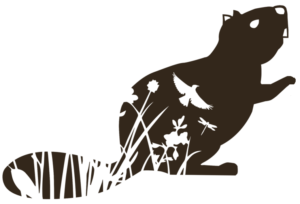Field Report 4: What Are The Beavers Eating Now?
Mid-Winter Dietary and Harvest Observations
Beavers being the mighty herbivores they are, commonly behave as energy-maximizers — choosing food that is of high quality and low-search/handling time. All three Middle Deschutes River monitoring stations are showing this consistent browsing activity with a couple of curious and unique observations.
Check out the video here: https://youtu.be/fGF2e8_a3rY
Beaver Browse: What Are They Eating Now?
Trees They Like
Similar behaviors include preference for certain species of soft-wood species of trees within 20 feet of the river. Branches of native Red Alder (Alnus rubra) and native Red Willow (Salix laevigata) are by far the species of choice. There is only one completely felled tree, most of the tree harvesting happening now are select branches of under 6 inches in diameter. But these branches can be very long - there is one that is 18 feet and getting smaller as the beavers snip off a portion and take to the river bank to debark over an evening. This is energy-maximized with smaller tree branches taking less effort and longer shelf life.
The busiest browsing area noted is along a fairly popular walking trail upstream from Tetherow Crossing. Over a quarter of a mile, there are 3-4 beaver “grocery stores” of alders. One 50 + year old red alder has lost 4 limbs over the course of December. It appears to be the work of a single adult beaver, with a tiny bit of help from a kit.
At the start of the new year, the first signs of the beaver browsing on Red Willow (Salix laevigata) is becoming more regular. When I look hard enough into the inner willow stalk it’s like a quiver of shoots where you may see one green shoot that has been surgically nipped and tucked by a beaver. It’s fascinating to find these willows with just one shoot snipped in the middle of many. It appears the beavers are seeking the greenest ones. There is also a reason the beavers may not browse certain willows at certain times: there is growing evidence that trees put out chemical defenses when browsed. I wonder if this is why there is much sniffing and test nibbling before a beaver chows down in earnest on a harvested twig.
Unique Browsing Observations
The curious behavior observed by trail camera footage shows a beaver on 3 different occasions dragging long sawgrass streamers back towards its den. Is this dried vegetation a courtship gift (it is now mating season), a comfy blanket for the den, or are they eating it? Another recent, more rare observation was a beaver snipping a small Western Juniper (Juniperus occidentalis) and taking it back to the “feasting pond” 10 feet away and seemingly enjoying chewing the green needles. And, my favorite discovery of the kit tackling and chewing a frozen grass “popsicle.” Beavers remind me of how to shop seasonally at a farmers market.
Here’s also some interesting information about the health benefits of red alder - which may be another dietary need for beavers during these months of increased woody vegetation ingestion.
https://www.healthbenefitstimes.com/red-alder/
 JOIN US in supporting beaver success and native wildlife habitat in our Oregon high desert landscapes.
JOIN US in supporting beaver success and native wildlife habitat in our Oregon high desert landscapes.